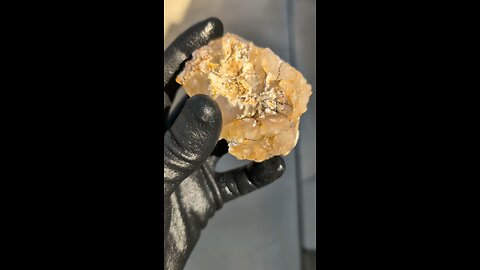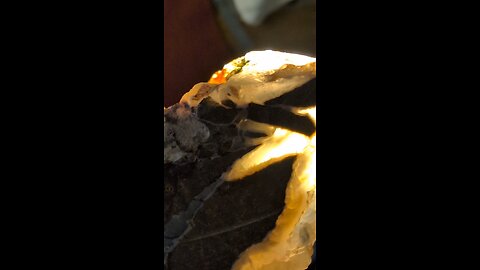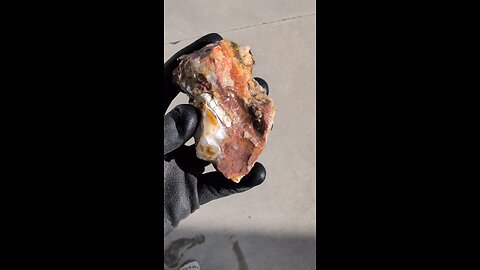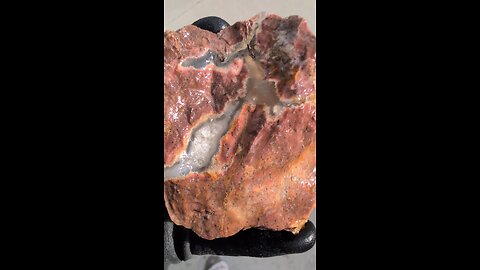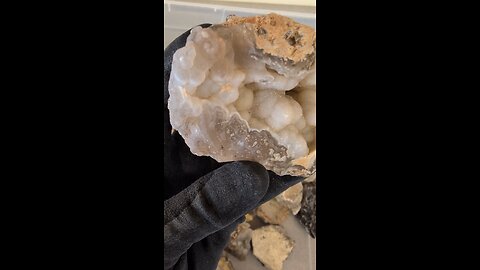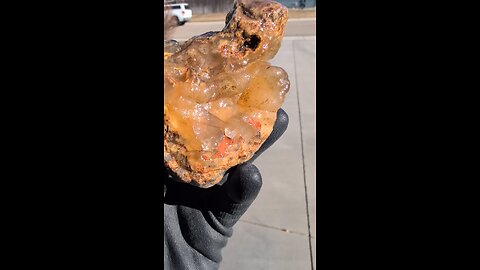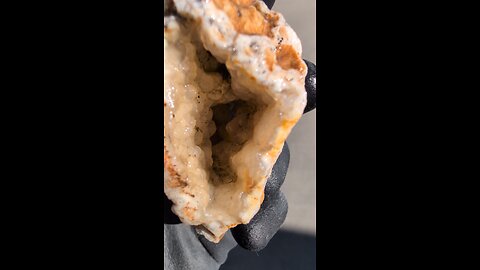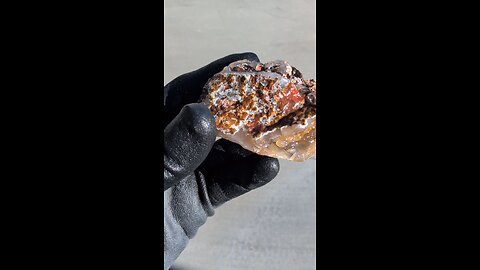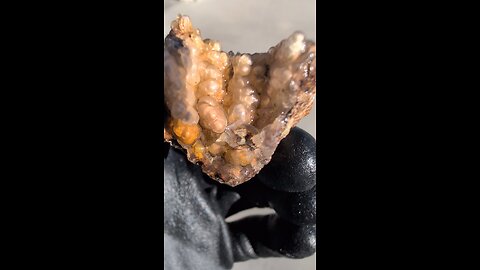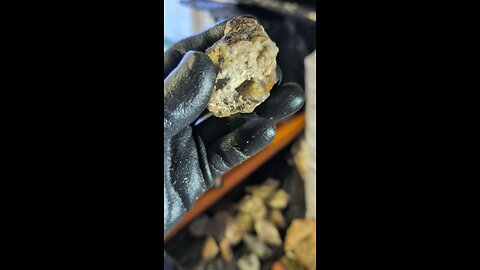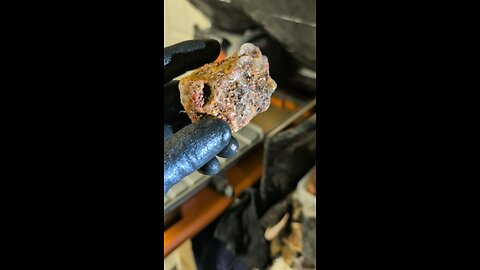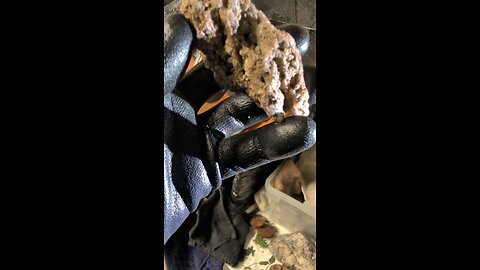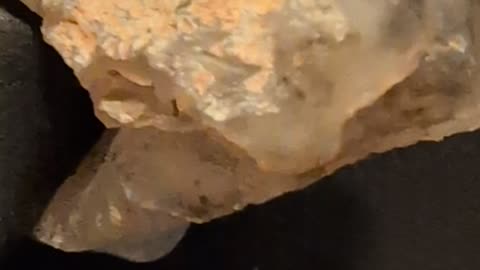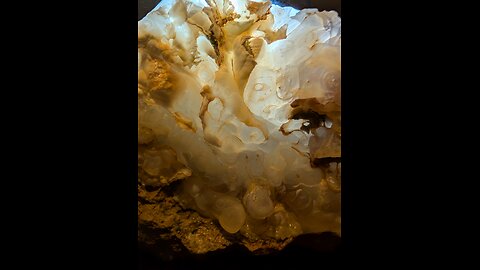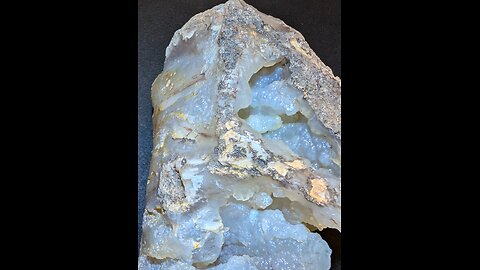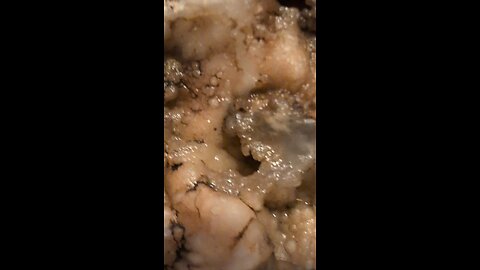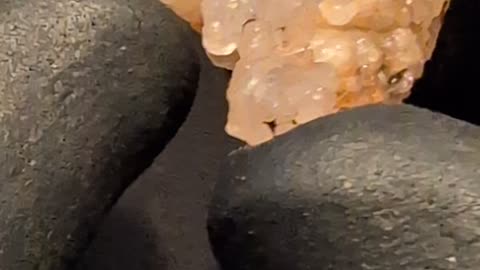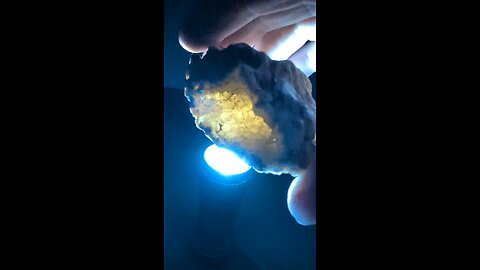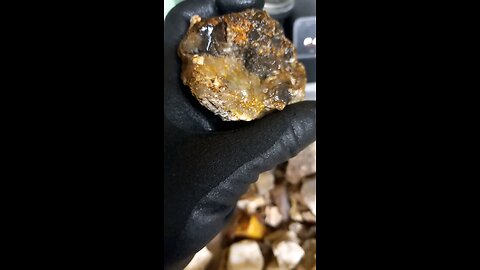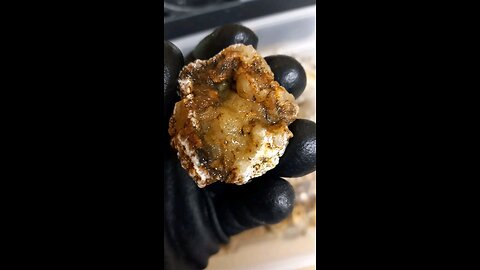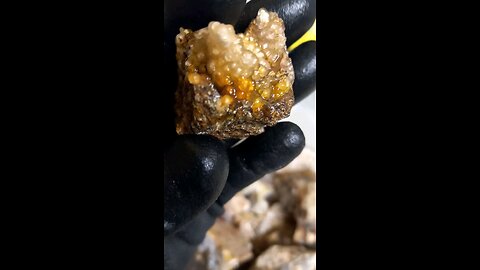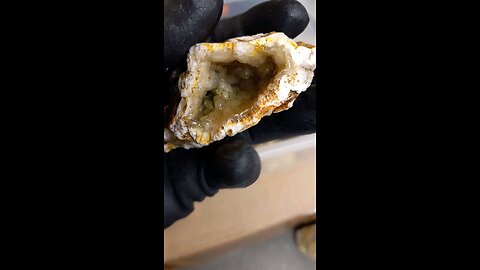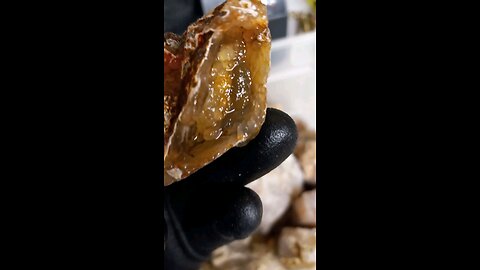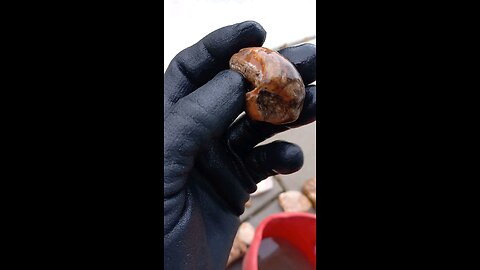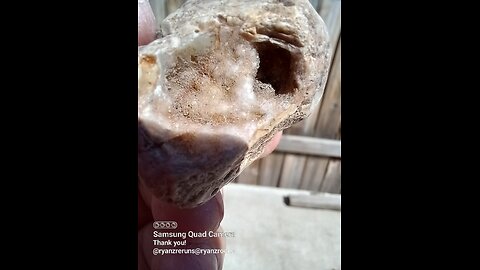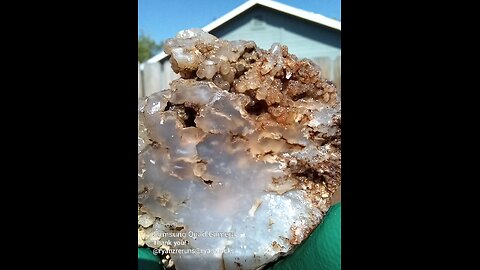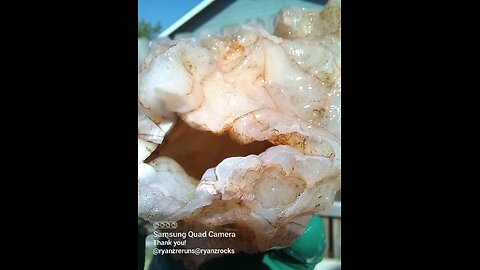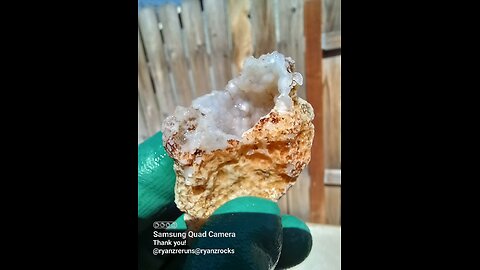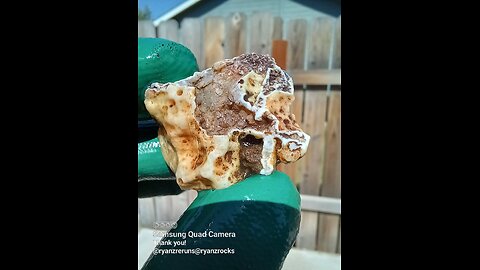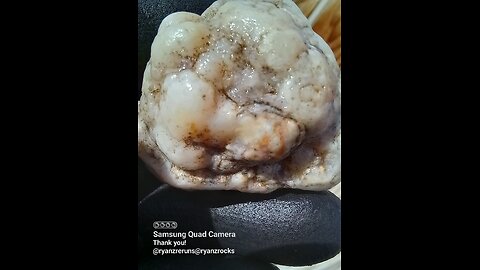Premium Only Content
This video is only available to Rumble Premium subscribers. Subscribe to
enjoy exclusive content and ad-free viewing.
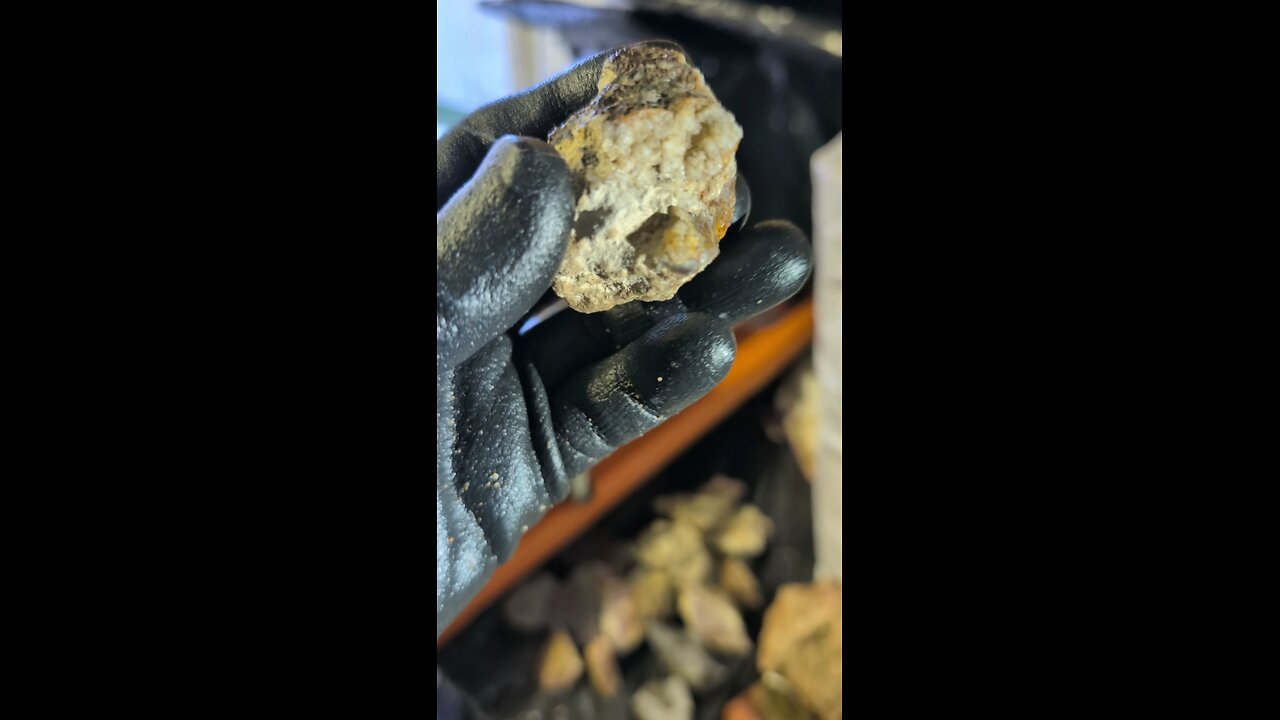
Botryoidal Formations!
HumbleConservative
- 10 / 32
1
Interesting Botryoidal Formation!
HumbleConservative
A botryoidal formation refers to a mineral structure that resembles a cluster of grapes or small, rounded, and knobby protrusions. Here are some details about botryoidal formations:
Characteristics:
Shape: The term "botryoidal" comes from the Greek word "botryoeides," meaning "grape-like." These formations have a surface that looks like a bunch of grapes.
Texture: They typically have a smooth, rounded surface, which can sometimes be polished to enhance their appearance.
Formation:
Process: Botryoidal formations occur when minerals precipitate from solution in a manner that favors the growth of rounded, nodular shapes. This often happens in cavities or vugs where mineral-rich fluids slowly deposit layers over time.
Common Minerals: Minerals that commonly form botryoidal structures include:
Hematite: Often found in botryoidal forms, giving a shiny, metallic luster.
Malachite: Known for its vibrant green color in botryoidal formations.
Goethite: Can exhibit botryoidal textures, often with a brownish to yellowish hue.
Chalcedony: Sometimes forms botryoidal structures, especially in agates.
Examples:
Botryoidal Hematite: Often found in iron-rich environments, it has a metallic sheen and can be polished to a high gloss.
Botryoidal Malachite: Famous for its green color and banding, often found in the oxidized zones of copper deposits.
Locations:
Botryoidal formations can be found worldwide in various geological settings where mineral precipitation occurs, from mines to natural rock formations.
Uses:
Decorative: Botryoidal minerals are popular in mineral collections and for decorative purposes due to their unique and attractive appearance.
Jewelry: Some botryoidal minerals like malachite are cut and polished for use in jewelry.
Botryoidal formations are fascinating because they provide insight into the conditions under which they formed, often indicating slow, steady mineral deposition in specific environmental conditions.
Plume agate is a distinctive variety of agate, known for its unique and intricate patterns that resemble plumes, feathers, or even landscapes. Here are some key points about plume agate:
Formation: Plume agate forms when silica-rich solutions seep into cavities in volcanic rocks. The "plumes" are created by manganese or iron oxides that get trapped in the silica, forming these feather-like patterns.
Colors: The colors of plume agate can vary widely depending on the minerals present. Common colors include reds, browns, yellows, blacks, and whites, with the plumes often contrasting against the base color of the agate.
Locations: Notable locations where plume agate is found include Oregon in the United States (specifically, the Owyhee Mountain area), Mexico, and Brazil. Each location can produce agates with unique characteristics.
Uses: Plume agate is popular among collectors and is often used in jewelry like pendants, rings, and beads due to its aesthetic appeal. It's also valued in metaphysical communities, where it's believed to enhance one's connection to the Earth, promote creativity, and aid in grounding.
Care: Like other agates, plume agate is relatively hard (about 6.5-7 on the Mohs scale), making it durable for jewelry. However, it should be protected from sharp blows or extreme temperature changes to avoid cracking.
Identification: When identifying plume agate, look for the characteristic plume-like inclusions. These inclusions should appear as if they are floating within the stone, giving a 3D effect when viewed from different angles.
Plume agate's beauty lies in its natural patterns, which can look like trees, clouds, or even abstract art, making each piece unique.
2
Botryoidal Chalcedony n' Jasper Glow!
HumbleConservative
Brecciated Jasper with chalcedony is a fascinating combination in the world of gemstones and minerals, offering both visual complexity and a unique geological story. Here's an overview:
Brecciated Jasper:
Formation: Brecciated Jasper forms when fragments of jasper (which is a form of microcrystalline quartz) are cemented together by a later mineral deposit. This process often involves the fracturing of existing jasper through geological activities like faulting or weathering, followed by the filling of these fractures with siliceous material, often chalcedony or quartz.
Appearance: The result is a rock with a mosaic-like appearance, where different colored jasper fragments are held together by the matrix. The colors can vary widely, but reds, browns, yellows, and greens are common, with the matrix often being a lighter or contrasting color.
Properties: Brecciated Jasper is known for its grounding and protective qualities in metaphysical circles. It's believed to stabilize energy and bring about feelings of wholeness and strength.
Chalcedony:
Nature: Chalcedony is a cryptocrystalline form of silica, consisting of very fine intergrowths of quartz and moganite. It can appear in a range of colors, from translucent white to various hues, depending on impurities.
In Brecciated Jasper: When chalcedony acts as the cement in Brecciated Jasper, it contributes to the stone's overall appearance by providing a contrasting matrix. This chalcedony can be translucent to semi-translucent, adding a different texture and sometimes color to the piece.
Visual Effect: The combination creates a striking visual contrast, where the angular or jagged pieces of jasper are highlighted against the smoother, often lighter chalcedony matrix. This can result in patterns that look like broken glass or stained glass windows.
Combined Properties:
Aesthetic: This combination is particularly sought after for its unique, mosaic-like beauty. It's used in jewelry, decorative items, and lapidary arts where the natural patterning can be showcased.
Geological Interest: From a geological perspective, this stone tells a story of disruption and healing in the Earth's crust, where old rock is broken and then naturally mended with new material.
Healing and Metaphysical Uses: The addition of chalcedony might enhance the stone's reputed healing properties, like promoting emotional balance, nurturing, and communication, complementing the stabilizing effects of jasper.
Availability and Use: You can find this type of jasper in various forms, from polished cabochons for jewelry to raw or tumbled stones for collectors or metaphysical use. It's sourced from places like Brazil, India, and the United States, among other locations.
When buying or working with Brecciated Jasper with chalcedony, look for pieces where the contrast between the jasper fragments and the chalcedony matrix is most pronounced for maximum visual impact. Remember, like all natural stones, each piece can be quite unique due to the natural processes involved in its formation.
3
Broken Thunderegg Cluster!
HumbleConservative
A Thunderegg is a geological structure similar to a geode but with unique characteristics. Here's an overview:
Formation: Thundereggs form within rhyolitic volcanic ash layers. They start as gas bubbles or steam pockets in the lava, which act as molds. Over time, these are filled with silica-rich fluids, mainly chalcedony, agate, jasper, or opal, creating intricate patterns and colors inside.
Appearance: On the outside, thundereggs look like ordinary, rough-textured rocks, often with a white-gray to reddish-brown surface. However, when cut and polished, they reveal a variety of internal structures, from solid agate or chalcedony cores to sometimes hollow centers with crystals.
Size: They can range from small, about the size of a baseball, to larger specimens over a meter across, though most commonly they are between two to six inches in diameter.
Locations: While Oregon, USA, is particularly famous for thundereggs, especially in counties like Crook, Jefferson, Malheur, Wasco, and Wheeler, they are found globally wherever the geological conditions are right. Other notable locations include Germany, Australia, Brazil, Canada, Mexico, Poland, Romania, and Turkey.
Cultural Significance: In Oregon, the thunderegg was designated as the state rock in 1965, reflecting its importance in local geology and culture. Native American legends attribute their formation to thunder spirits or gods throwing these rocks during thunderstorms.
Collection and Use: Thundereggs are popular among rock collectors for their unique beauty once cut open. They're often used in jewelry making or as display pieces due to their aesthetic appeal after being sliced and polished.
Variations: Each thunderegg is unique due to the minerals present in the area where it forms, leading to a wide variety in color, pattern, and structure even from the same bed.
4
Chalcedony n' Quartz Veins!
HumbleConservative
Chalcedony is a cryptocrystalline form of silica, which means it's composed of very fine intergrowths of quartz and moganite. These crystals are so small that they can only be seen under high magnification. Chalcedony has a waxy luster and can appear in a variety of colors, often due to impurities or inclusions within the stone. Here are some key points about chalcedony:
Composition: It's primarily made of silica (SiO₂), with quartz and moganite being the two main components.
Varieties: Chalcedony includes several well-known gemstones like agate, onyx, jasper, carnelian, and chrysoprase, each with distinct patterns or colors.
Formation: It typically forms in the cavities of volcanic rocks, where silica-rich solutions deposit over time.
Properties: It has a hardness of 6.5 to 7 on the Mohs scale, making it quite durable. Its toughness and ability to take a high polish make it popular in jewelry and decorative items.
Uses: Besides being used in jewelry, chalcedony has historical significance in tool-making, art, and even as a gemstone for metaphysical purposes.
5
Botryoidal Geode!
HumbleConservative
This rock appears to be a geode filled with chalcedony or agate. Here's a detailed explanation:
Geode: Geodes are hollow, vaguely spherical rocks, often formed in volcanic and sedimentary rocks. They have a thin outer layer and are typically lined with crystals inside. The one in the image has been cut open to reveal its interior.
Chalcedony: This is a cryptocrystalline form of silica, composed of very fine intergrowths of quartz and moganite. Chalcedony can appear in various colors and forms, including agate, which has banding or layers.
Agate: If the chalcedony within the geode shows banding or layers, it could be classified as agate. Agate typically has more distinct color bands, which might not be very clear in this specimen due to the type of formation or the cut.
Formation: Geodes form when gas bubbles or volcanic cavities get filled with mineral-rich water. Over time, the minerals precipitate out of the water, forming layers or crystals inside the cavity. In this case, the minerals appear to have formed botryoidal (grape-like) structures, which is common in chalcedony.
Appearance: The white to light gray, rounded, botryoidal formations inside the geode suggest chalcedony. The outer shell seems to be a mix of quartz and possibly some iron staining, giving it the brownish hues.
6
Botryoidal Carnelean!
HumbleConservative
This rock houses Carnelian, a type of chalcedony known for its rich, translucent, and warm orange to red-brown color. Here's why this identification might fit:
Color: Carnelian typically exhibits a range of colors from pale orange to deep red-brown, which matches the coloration seen in the rock in the image.
Translucency: Carnelian is often translucent to semi-translucent, which aligns with the way the light passes through the rock in the image, giving it a somewhat glassy appearance.
Layering: While not as pronounced as in banded agates, carnelian can sometimes show subtle banding or layers of color, which might be seen in the varying shades of orange and brown in the rock.
Texture: Carnelian has a waxy luster when polished, much like other forms of chalcedony, which seems consistent with the appearance of the rock in the image.
Carnelian is often used in jewelry and decorative items due to its vibrant color and attractive appearance. If this rock has been polished or cut for ornamental use, it would ty
7
Botryoidal Geode!
HumbleConservative
A geode is a hollow, usually spherical rock, that when broken open reveals a cavity lined with crystals or other mineral formations. Here are some key points about geodes:
Formation: Geodes form when gas bubbles or cavities in volcanic or sedimentary rock are filled with mineral-rich water. As the water evaporates, it leaves behind minerals which crystallize over time, lining the inside of the cavity.
Structure: The outer layer of a geode is typically rough and nondescript, often making it look like an ordinary rock until it's cracked open. Inside, you might find crystals like quartz, amethyst, calcite, or even rarer minerals.
Location: They are commonly found in regions with volcanic activity or limestone deposits. Famous locations include parts of the United States, Brazil, Uruguay, and Mexico.
Uses: Geodes are popular among rock collectors and are often cut and polished for use in jewelry or as decorative pieces. Some are also used in metaphysical practices for their supposed healing properties.
8
Botryoidal Plume Agate!
HumbleConservative
A botryoidal formation refers to a mineral structure that resembles a cluster of grapes or small, rounded, and knobby protrusions. Here are some details about botryoidal formations:
Characteristics:
Shape: The term "botryoidal" comes from the Greek word "botryoeides," meaning "grape-like." These formations have a surface that looks like a bunch of grapes.
Texture: They typically have a smooth, rounded surface, which can sometimes be polished to enhance their appearance.
Formation:
Process: Botryoidal formations occur when minerals precipitate from solution in a manner that favors the growth of rounded, nodular shapes. This often happens in cavities or vugs where mineral-rich fluids slowly deposit layers over time.
Common Minerals: Minerals that commonly form botryoidal structures include:
Hematite: Often found in botryoidal forms, giving a shiny, metallic luster.
Malachite: Known for its vibrant green color in botryoidal formations.
Goethite: Can exhibit botryoidal textures, often with a brownish to yellowi
9
Botryoidal Formation!
HumbleConservative
A botryoidal formation refers to a mineral structure that resembles a cluster of grapes or small, rounded, and knobby protrusions. Here are some details about botryoidal formations:
Characteristics:
Shape: The term "botryoidal" comes from the Greek word "botryoeides," meaning "grape-like." These formations have a surface that looks like a bunch of grapes.
Texture: They typically have a smooth, rounded surface, which can sometimes be polished to enhance their appearance.
Formation:
Process: Botryoidal formations occur when minerals precipitate from solution in a manner that favors the growth of rounded, nodular shapes. This often happens in cavities or vugs where mineral-rich fluids slowly deposit layers over time.
Common Minerals: Minerals that commonly form botryoidal structures include:
Hematite: Often found in botryoidal forms, giving a shiny, metallic luster.
Malachite: Known for its vibrant green color in botryoidal formations.
Goethite: Can exhibit botryoidal textures, often with a brownish to yellowi
Ooids inside!
HumbleConservative
Based on the appearance of the rock in the image, it looks like it could be a type of limestone known as oolitic limestone. Oolitic limestone is characterized by its small, spherical or oval grains called ooids, which are visible in the rock's texture. These ooids are typically formed in shallow marine environments and are composed of concentric layers of calcium carbonate.
The rock in the image shows a pattern of small, rounded structures embedded in a matrix, which is typical of oolitic limestone.
11
Brecciated Jasper Cut!
HumbleConservative
Brecciated Jasper is a type of jasper that is characterized by its appearance as broken fragments or pieces of jasper that have been naturally cemented together. Here's a more detailed explanation:
Formation: Brecciated Jasper forms when existing jasper is fractured or broken into pieces due to geological processes like tectonic activity or weathering. These fragments are then cemented together by silica or other minerals, often quartz, which fills the spaces between the fragments.
Appearance: It typically has a distinctive, mosaic-like pattern where the jasper fragments are angular and vary in size, creating a visually striking contrast with the matrix that holds them together. The colors can range from red, brown, yellow, to white, depending on the impurities present in the jasper and the matrix material.
Uses: Due to its unique and attractive pattern, Brecciated Jasper is commonly used in jewelry, carvings, and decorative items. It's valued for its aesthetic appeal and the interesting geological story it tells.
Properties: Like other types of jasper, Brecciated Jasper is relatively hard (around 6.5 to 7 on the Mohs scale), making it durable for various uses. It also has a waxy to vitreous luster when polished.
This type of jasper not only adds beauty to various crafts but also provides insight into the geological processes that have shaped our planet.
12
Botryoidal Plume Cut!
HumbleConservative
Plume agate is a distinctive variety of agate, known for its unique and intricate patterns that resemble plumes, feathers, or even landscapes. Here are some key points about plume agate:
Formation: Plume agate forms when silica-rich solutions seep into cavities in volcanic rocks. The "plumes" are created by manganese or iron oxides that get trapped in the silica, forming these feather-like patterns.
Colors: The colors of plume agate can vary widely depending on the minerals present. Common colors include reds, browns, yellows, blacks, and whites, with the plumes often contrasting against the base color of the agate.
Locations: Notable locations where plume agate is found include Oregon in the United States (specifically, the Owyhee Mountain area), Mexico, and Brazil. Each location can produce agates with unique characteristics.
Uses: Plume agate is popular among collectors and is often used in jewelry like pendants, rings, and beads due to its aesthetic appeal. It's also valued in metaphysical communities, where it's believed to enhance one's connection to the Earth, promote creativity, and aid in grounding.
Care: Like other agates, plume agate is relatively hard (about 6.5-7 on the Mohs scale), making it durable for jewelry. However, it should be protected from sharp blows or extreme temperature changes to avoid cracking.
Identification: When identifying plume agate, look for the characteristic plume-like inclusions. These inclusions should appear as if they are floating within the stone, giving a 3D effect when viewed from different angles.
Plume agate's beauty lies in its natural patterns, which can look like trees, clouds, or even abstract art, making each piece unique.
13
Plume botryoidal chalcedony nugget!
HumbleConservative
Plume Agate is a captivating variety of agate, renowned for its intricate and delicate feather-like inclusions. These mesmerizing formations resemble ethereal plumes or wisps suspended within the stone, creating a stunning visual effect. It belongs to the chalcedony family, characterized by its microcrystalline structure and vibrant colors.
Plume Agate derives its name from the feathery patterns that adorn its surface. These patterns are typically composed of mineral deposits, often in striking hues such as white, cream, pink, or red, contrasting against a translucent or opaque background. These intricate formations are formed through the slow crystallization of silica-rich solutions within cavities or fissures in volcanic rocks.
Each piece of Plume Agate is unique, showcasing a kaleidoscope of colors and patterns. The delicate plumes within the stone evoke a sense of tranquility and beauty, making it a highly sought-after gemstone among collectors and jewelry enthusiasts alike.
Plume Agate holds significant importance in the world of gemstones and jewelry for several reasons:
Aesthetic Appeal: Plume Agate’s captivating patterns and vibrant colors make it a favorite among jewelry designers and collectors. Its unique beauty adds an element of elegance and individuality to any piece of jewelry.
Metaphysical Properties: In addition to its visual allure, Plume Agate is believed to possess metaphysical properties that promote harmony, balance, and emotional healing. It is often used in alternative healing practices and spiritual rituals.
Collectibility: Due to its rarity and unique characteristics, Plume Agate is highly prized by gemstone collectors. Specimens with exceptional plume formations or intense colors can command high prices in the market.
Versatility: Plume Agate’s diverse color palette and patterns make it a versatile gemstone for jewelry design. It can be fashioned into various shapes and sizes, including cabochons, beads, and carvings, allowing for creativity and innovation in jewelry making.
Historical Significance: Throughout history, agates have been revered for their beauty and perceived mystical properties. Plume Agate, with its distinct plume-like inclusions, has been admired and utilized in adornments and talismans by ancient civilizations.
Plume Agate stands out as a gemstone of exceptional beauty, imbued with both aesthetic and metaphysical significance. Its popularity in the world of gemstones and jewelry continues to endure, captivating admirers with its mesmerizing patterns and timeless allure.
- https://geologyscience.com/gemstone/plume-agate/
14
Plume slice!
HumbleConservative
Plume Agate is a captivating variety of agate, renowned for its intricate and delicate feather-like inclusions. These mesmerizing formations resemble ethereal plumes or wisps suspended within the stone, creating a stunning visual effect. It belongs to the chalcedony family, characterized by its microcrystalline structure and vibrant colors.
Plume Agate derives its name from the feathery patterns that adorn its surface. These patterns are typically composed of mineral deposits, often in striking hues such as white, cream, pink, or red, contrasting against a translucent or opaque background. These intricate formations are formed through the slow crystallization of silica-rich solutions within cavities or fissures in volcanic rocks.
Each piece of Plume Agate is unique, showcasing a kaleidoscope of colors and patterns. The delicate plumes within the stone evoke a sense of tranquility and beauty, making it a highly sought-after gemstone among collectors and jewelry enthusiasts alike.
Plume Agate holds significant importance in the world of gemstones and jewelry for several reasons:
Aesthetic Appeal: Plume Agate’s captivating patterns and vibrant colors make it a favorite among jewelry designers and collectors. Its unique beauty adds an element of elegance and individuality to any piece of jewelry.
Metaphysical Properties: In addition to its visual allure, Plume Agate is believed to possess metaphysical properties that promote harmony, balance, and emotional healing. It is often used in alternative healing practices and spiritual rituals.
Collectibility: Due to its rarity and unique characteristics, Plume Agate is highly prized by gemstone collectors. Specimens with exceptional plume formations or intense colors can command high prices in the market.
Versatility: Plume Agate’s diverse color palette and patterns make it a versatile gemstone for jewelry design. It can be fashioned into various shapes and sizes, including cabochons, beads, and carvings, allowing for creativity and innovation in jewelry making.
Historical Significance: Throughout history, agates have been revered for their beauty and perceived mystical properties. Plume Agate, with its distinct plume-like inclusions, has been admired and utilized in adornments and talismans by ancient civilizations.
Plume Agate stands out as a gemstone of exceptional beauty, imbued with both aesthetic and metaphysical significance. Its popularity in the world of gemstones and jewelry continues to endure, captivating admirers with its mesmerizing patterns and timeless allure.
- https://geologyscience.com/gemstone/plume-agate/
15
Botryoidal slice!
HumbleConservative
Plume Agate is a captivating variety of agate, renowned for its intricate and delicate feather-like inclusions. These mesmerizing formations resemble ethereal plumes or wisps suspended within the stone, creating a stunning visual effect. It belongs to the chalcedony family, characterized by its microcrystalline structure and vibrant colors.
Plume Agate derives its name from the feathery patterns that adorn its surface. These patterns are typically composed of mineral deposits, often in striking hues such as white, cream, pink, or red, contrasting against a translucent or opaque background. These intricate formations are formed through the slow crystallization of silica-rich solutions within cavities or fissures in volcanic rocks.
Each piece of Plume Agate is unique, showcasing a kaleidoscope of colors and patterns. The delicate plumes within the stone evoke a sense of tranquility and beauty, making it a highly sought-after gemstone among collectors and jewelry enthusiasts alike.
Plume Agate holds significant importance in the world of gemstones and jewelry for several reasons:
Aesthetic Appeal: Plume Agate’s captivating patterns and vibrant colors make it a favorite among jewelry designers and collectors. Its unique beauty adds an element of elegance and individuality to any piece of jewelry.
Metaphysical Properties: In addition to its visual allure, Plume Agate is believed to possess metaphysical properties that promote harmony, balance, and emotional healing. It is often used in alternative healing practices and spiritual rituals.
Collectibility: Due to its rarity and unique characteristics, Plume Agate is highly prized by gemstone collectors. Specimens with exceptional plume formations or intense colors can command high prices in the market.
Versatility: Plume Agate’s diverse color palette and patterns make it a versatile gemstone for jewelry design. It can be fashioned into various shapes and sizes, including cabochons, beads, and carvings, allowing for creativity and innovation in jewelry making.
Historical Significance: Throughout history, agates have been revered for their beauty and perceived mystical properties. Plume Agate, with its distinct plume-like inclusions, has been admired and utilized in adornments and talismans by ancient civilizations.
Plume Agate stands out as a gemstone of exceptional beauty, imbued with both aesthetic and metaphysical significance. Its popularity in the world of gemstones and jewelry continues to endure, captivating admirers with its mesmerizing patterns and timeless allure.
- https://geologyscience.com/gemstone/plume-agate/
16
Plume agate inspection!
HumbleConservative
Plume Agate is a captivating variety of agate, renowned for its intricate and delicate feather-like inclusions. These mesmerizing formations resemble ethereal plumes or wisps suspended within the stone, creating a stunning visual effect. It belongs to the chalcedony family, characterized by its microcrystalline structure and vibrant colors.
Plume Agate derives its name from the feathery patterns that adorn its surface. These patterns are typically composed of mineral deposits, often in striking hues such as white, cream, pink, or red, contrasting against a translucent or opaque background. These intricate formations are formed through the slow crystallization of silica-rich solutions within cavities or fissures in volcanic rocks.
Each piece of Plume Agate is unique, showcasing a kaleidoscope of colors and patterns. The delicate plumes within the stone evoke a sense of tranquility and beauty, making it a highly sought-after gemstone among collectors and jewelry enthusiasts alike.
Plume Agate holds significant importance in the world of gemstones and jewelry for several reasons:
Aesthetic Appeal: Plume Agate’s captivating patterns and vibrant colors make it a favorite among jewelry designers and collectors. Its unique beauty adds an element of elegance and individuality to any piece of jewelry.
Metaphysical Properties: In addition to its visual allure, Plume Agate is believed to possess metaphysical properties that promote harmony, balance, and emotional healing. It is often used in alternative healing practices and spiritual rituals.
Collectibility: Due to its rarity and unique characteristics, Plume Agate is highly prized by gemstone collectors. Specimens with exceptional plume formations or intense colors can command high prices in the market.
Versatility: Plume Agate’s diverse color palette and patterns make it a versatile gemstone for jewelry design. It can be fashioned into various shapes and sizes, including cabochons, beads, and carvings, allowing for creativity and innovation in jewelry making.
Historical Significance: Throughout history, agates have been revered for their beauty and perceived mystical properties. Plume Agate, with its distinct plume-like inclusions, has been admired and utilized in adornments and talismans by ancient civilizations.
Plume Agate stands out as a gemstone of exceptional beauty, imbued with both aesthetic and metaphysical significance. Its popularity in the world of gemstones and jewelry continues to endure, captivating admirers with its mesmerizing patterns and timeless allure.
- https://geologyscience.com/gemstone/plume-agate/
17
Botryoidal Chalcedony Nugget!
HumbleConservative
Chalcedony, a microcrystalline variety of quartz. It forms in concentric layers within cavities of rocks, typically igneous rocks such as volcanic basalt. Botryoidal agate forms when layers of silica-rich fluids deposit successive layers of chalcedony around a central nucleus, creating these distinctive rounded shapes.
One of the most intriguing aspects of botryoidal agate is its diverse range of colors and patterns. These patterns are often accentuated by the unique banding and translucency inherent to agate. From vibrant hues of blue, green, and purple to earthy tones of brown and gray, each specimen showcases its own distinct beauty.
1
comment
18
Botryoidal Glow!
HumbleConservative
This rock appears to be an example of an open geode. Geodes are typically characterized by their hollow or partially hollow interiors, which are often lined with crystals or minerals. Here's why:
Texture and Appearance: The rock in the image has a rough exterior with a somewhat nodular surface, which is typical for geodes. The interior seems to contain a liquid or a crystalline substance, which is consistent with the internal structure of many geodes.
Possible Mineral Content: The yellowish-brown coloration and the appearance of liquid or crystalline material suggest the presence of minerals like quartz or calcite, which are common in geodes.
Formation: Geodes form when gas bubbles are trapped in volcanic rocks or sedimentary layers. Over time, minerals precipitate from water seeping through the rock, lining the cavity with crystals.
19
Hot Botryoidal Mess!
HumbleConservative
Plume agate is a variety of chalcedony, a microcrystalline quartz, characterized by delicate, plume-like inclusions of various colors and minerals. These inclusions often resemble feathers, flowers, or flames, giving the agate a unique and visually appealing appearance.
Plume agate only forms in hotsprings with the help of thermophiles and extremophiles (microscopic organisms that like harsh and hot environments) collecting silica and other dissolved particles in silica rich hotsprings and depositing them in wild patterns within the agate.
A combination of clays, metals and minerals make up the cool colors and textures we experience.
There are many famous deposits of plume, flame and other varieties of textures made with the assistance of microbes.
20
Half of a geode!
HumbleConservative
This rock appears to be a type of geode, specifically an agate geode. The outer part is typically composed of a layer of chalcedony, which is a form of silica, often found in volcanic and metamorphic rocks. The inside, as seen in the photo, shows botryoidal formations, which are grape-like clusters, commonly formed by the deposition of minerals from groundwater within the cavities of the rock. The white and translucent nature of the interior suggests it could be lined with quartz or agate, which often forms in such structures. These formations are prized for their beauty and are often cut and polished for use in jewelry or as decorative pieces.
21
Botryoidal formations!
HumbleConservative
Plume agate is a variety of chalcedony, a microcrystalline quartz, characterized by delicate, plume-like inclusions of various colors and minerals. These inclusions often resemble feathers, flowers, or flames, giving the agate a unique and visually appealing appearance.
Plume agate only forms in hotsprings with the help of thermophiles and extremophiles (microscopic organisms that like harsh and hot environments) collecting silica and other dissolved particles in silica rich hotsprings and depositing them in wild patterns within the agate.
A combination of clays, metals and minerals make up the cool colors and textures we experience.
There are many famous deposits of plume, flame and other varieties of textures made with the assistance of microbes.
22
This half survived Monther Nature!
HumbleConservative
This rock appears to be a type of geode, specifically an agate geode. The outer part is typically composed of a layer of chalcedony, which is a form of silica, often found in volcanic and metamorphic rocks. The inside, as seen in the photo, shows botryoidal formations, which are grape-like clusters, commonly formed by the deposition of minerals from groundwater within the cavities of the rock. The white and translucent nature of the interior suggests it could be lined with quartz or agate, which often forms in such structures. These formations are prized for their beauty and are often cut and polished for use in jewelry or as decorative pieces.
23
Broken geode!
HumbleConservative
This rock appears to be a type of geode, specifically an agate geode. The outer part is typically composed of a layer of chalcedony, which is a form of silica, often found in volcanic and metamorphic rocks. The inside, as seen in the photo, shows botryoidal formations, which are grape-like clusters, commonly formed by the deposition of minerals from groundwater within the cavities of the rock. The white and translucent nature of the interior suggests it could be lined with quartz or agate, which often forms in such structures. These formations are prized for their beauty and are often cut and polished for use in jewelry or as decorative pieces.
24
Some botryoidal goins' on!
HumbleConservative
Agate is a semiprecious gemstone that is a variety of chalcedony, a type of quartz:
Appearance
Agate is known for its concentric bands of color, which can be white, gray, yellowish-brown, reddish-brown, blue, or green. The colors come from iron oxide minerals in the quartz.
Formation
Agate forms in cavities in volcanic and metamorphic rocks over thousands of years. Silica-rich water deposits quartz crystals in layers that are parallel to the cavity walls.
Uses
Agate is a popular choice for jewelry and carvings because of its beauty and toughness. It has been used to make beads, cabochons, and cameos.
Origin
The name agate comes from the river Achates (now Dirillo) in southwest Sicily, where it was discovered. However, some modern etymologists believe the river was named after the stone.
Other names
Agate has many names, including eye agate, lace agate, and moss agate.
Location
Agate is found all over the world, but Brazil is the main commercial source. In the United States, the western states of Oregon, Washington, Idaho, and Montana are the main sources.
26
27
It's hollow!
HumbleConservative
@RyanzRocks #noob #rockhound #rockformation #tumbling #agates #rocks #rockhounders #rockstructure #metamorphicrocks #metamorphic #igneousrocks #igneous #quartz #quartzite #geology #nodules #minerals #crystals #glowrocks #idahorockhunting #idahogems #rockcutting #thundereggs #chalcedony #opal #lavarock #rigidtools #ryobitools #riverrocks #translucentrocks #translucent #rockgarden #flow #vevortools #jasper #granite #caves #marble #carnelian #gneiss #limestone #calcite #gold #silver #botryoidal
30
Botryoidal chalcedony!
HumbleConservative
Plume agate is a variety of chalcedony, a microcrystalline quartz, characterized by delicate, plume-like inclusions of various colors and minerals. These inclusions often resemble feathers, flowers, or flames, giving the agate a unique and visually appealing appearance.
Plume agate only forms in hotsprings with the help of thermophiles and extremophiles (microscopic organisms that like harsh and hot environments) collecting silica and other dissolved particles in silica rich hotsprings and depositing them in wild patterns within the agate.
A combination of clays, metals and minerals make up the cool colors and textures we experience.
There are many famous deposits of plume, flame and other varieties of textures made with the assistance of microbes.
31
White botryoidal chalcedony?
HumbleConservative
@RyanzRocks #noob #rockhound #rockformation #tumbling #agates #rocks #rockhounders #rockstructure #metamorphicrocks #metamorphic #igneousrocks #igneous #quartz #quartzite #geology #nodules #minerals #crystals #glowrocks #idahorockhunting #idahogems #rockcutting #thundereggs #chalcedony #opal #lavarock #rigidtools #ryobitools #riverrocks #translucentrocks #translucent #rockgarden #flow #vevortools #jasper #granite #caves #marble #carnelian #gneiss #limestone #calcite #gold #silver #botryoidal
32
Botryoidal chalcedony!
HumbleConservative
The rock in the image appears to be a type of chalcedony, possibly an agate or a similar variety. Here's why:
1. **Coloration and Banding**: The rock has a predominantly white or light gray color with some yellowish-brown inclusions. This kind of coloration and banding is typical for agates, which are a variety of chalcedony.
2. **Translucency**: Chalcedony, including agate, often has a translucent quality, which seems to be present in parts of this rock.
3. **Texture**: The rock's texture looks somewhat waxy or greasy, which is characteristic of chalcedony due to its fine-grained silica composition.
4. **Inclusions**: The yellowish-brown areas could be iron oxide or other mineral inclusions, which are common in agates and give them their varied colors. However, without specific tests like a hardness test, streak test, or chemical analysis, this identification remains speculative. For a more precise identification: - **Hardness Test**: Chalcedony has a hardness of around 7 on the Mohs scale, meaning it should scratch glass but not be scratched by a knife. - **Streak Test**: The streak of chalcedony (if it could be powdered) would typically be white or colorless. - **Microscopic Analysis**: Looking at thin sections under a microscope could reveal the mineral composition more clearly. - **Consulting a Geologist or Using Spectroscopy**: For a definitive identification, especially if this rock might be of value or scientific interest.
Ooids inside!
3 months ago
52
Based on the appearance of the rock in the image, it looks like it could be a type of limestone known as oolitic limestone. Oolitic limestone is characterized by its small, spherical or oval grains called ooids, which are visible in the rock's texture. These ooids are typically formed in shallow marine environments and are composed of concentric layers of calcium carbonate.
The rock in the image shows a pattern of small, rounded structures embedded in a matrix, which is typical of oolitic limestone.
Loading comments...
-
 12:26
12:26
EvenOut
8 hours ago $3.23 earnedWe Got Cosmestic Surgery That Went Wrong! Twin Switch-Up!
20.3K4 -
 1:15:07
1:15:07
Ami's House
14 hours ago $1.57 earnedWhat an ACTUAL Military Expert Thinks of the War in Gaza – Nick Freitas | FULL EP
12.4K7 -
 2:54:02
2:54:02
TimcastIRL
6 hours agoLiberal Media CAUGHT In BOGUS LEAK, Trump DID NOT Fire Mike Waltz, HE PROMOTED HIM | Timcast IRL
188K104 -
 LIVE
LIVE
MyronGainesX
13 hours ago $18.04 earnedSam Seder Embarrasses Ethan Klein, The Truth On MLK's Murder, And Trump's First 100 Days In Review
2,232 watching -
 1:09:38
1:09:38
Man in America
9 hours agoEXPOSED: How Militaries Worldwide Are Engineering DEPOPULATION w/ Todd Callender
47.1K26 -
 LIVE
LIVE
SpartakusLIVE
8 hours agoNEW Update, NEW Weapons, NEW META?!? || Quads in VERDANSK
245 watching -

Jokeuhl Gaming and Chat
5 hours agoEmpyrion - Galactic Survival Long Range Jump Aquired
21K1 -
 4:42:30
4:42:30
Right Side Broadcasting Network
1 day agoLIVE REPLAY: President Trump Gives Commencement Address at University of Alabama - 5/1/25
152K19 -
 16:58
16:58
T-SPLY
12 hours agoDems’ Bad News: El Salvador Rejects Abrego, Democrats Fume!
81.3K57 -
 18:56
18:56
Nick Shirley
7 hours ago $3.23 earnedAsking People About Trump’s First 100 Days… How are Americans Feeling?
28.6K34
